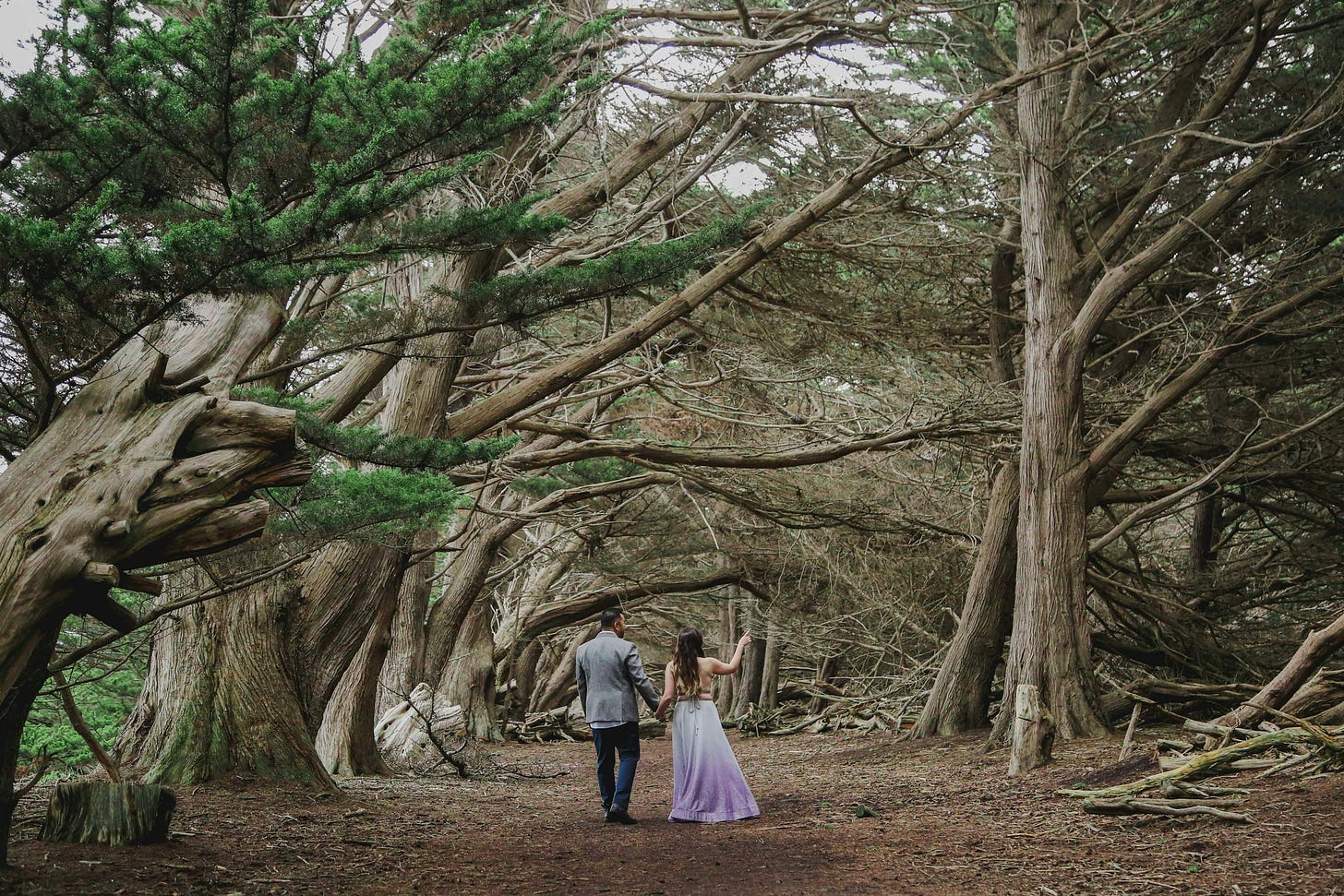Photo by Silas Baisch on Unsplash
Synesthesia and Its Dreamlike Effects
Good afternoon, Seized Readers.
Can we talk about our sleeping lives and the magical world of dreams? Only in dreams can we taste chocolate in a rain shower or feel the scratch of a clock ticking. Have you experienced a dream where colors danced or moonlight murmured? I have awakened only to have them go poof, evaporate before I could write down the details … more about capturing dreams later in this post.
Do these images I referenced above seem surreal to you? If you answered “Yes,” that leads to my point: Not only do poets intensify our experience of a poem by incorporating sights, sounds, tastes, and textures, but they also blend these senses in original, often dreamlike imagery.
What dreams have you experienced? Have you used your dream images in your writing?
Take a look at my poem, “Bonsho,” to experience a few surreal images:
Bonsho Outside the temple, three bells swing./ First cast in wax, covered with clay—/ earthen foundry/ molded./ From silt to song,/ earth to air,/ echoing the ages,/ ringing the divine./ An elder at her kitchen sink,/ cratered hands scrubbing a rice pot,/ turns off the tap/ to hear the water of bronze./ In her vision a peal of light./ In her ears the echo of ancestors/ singing in the hills. –Diana Ewell Engel, from Excavating Light
Photo by Diana Ewell Engel of the nesting cowbells
Years ago, my mother gave me a tether of nesting cowbells from India. This gift ignited my imagination, and the bells became a jumping-off point for my poem, “Bonsho.” For my poem, I changed these bells to be of Japanese origin. The visual that sprang to mind was of an elderly Japanese woman washing dishes when she hears the bells of a nearby Buddhist temple ring.
When I write a poem, I seek to do more than provide vivid description. I want to transport the reader to a deeper level of experience.
In “Bonsho,” I express not only how a clay-crafted object can deliver beautiful song, but what interpreting effect that song can have on the ears and mind: “echoing the ages, / ringing the divine” (first stanza, lines 7-8).
The elder is so moved that she “turns off the tap / to hear the water of bronze” (last stanza, lines 3-4). How is it that she can hear the water of bronze? The bells haven’t been immersed in water nor can we hear water in a bell’s toll. I’m dovetailing this image with the tap water she’s using to scrub a rice pot, moving from its utilitarian use to a poetic meaning, invoking several ideas such as how the sea brought ancestors to Japan and the reflective nature of water.
Photo by the CDC on Unsplash
In this image, I use a poetic technique called synesthesia. The sense of sight conveyed by the image of water blends with the sense of hearing the bells toll.
A stronger synesthetic image then follows: “In her vision a peal of light” (line 5). Light makes a visual impression, not auditory. This elder sees and hears—in her mind’s eye—light which is tolling like the Bonsho bells. Again, I’m mixing the senses to say more. Instead of writing, She sees light, I express that the light sounds like the bells pealing in the air. I want to convey the deep rush of connection to her ancestors which this woman is feeling—ancestors whom she hears “singing in the hills” (line 7).
Simply stated, synesthesia means that when one sense such as the sound of bells is activated, another sense such as the sight of light reacts. When used effectively by the poet at the right juncture, synesthesia deepens the emotional meaning of a poem.
Photo by Sebastian Unrau on Unsplash
Turning to Kenneth Rexroth’s poem, “Asagumori:”
Asagumori On the forest path/ The leaves fall. In the withered/ Grass the crickets sing/ Their last songs. Through dew and dusk/ I walk the paths you once walked,/ My sleeves wet with memory. - Kenneth Rexroth , from his collection, The Silver Swan: Poems Written in Kyoto, 1974-1975.
Photo by Katherine Carlyon on Unsplash
What is the synesthetic image in “Asagumori?”
With his imagery of cascading leaves, crickets chirping their end-of-life songs in dying grass, and the dew and dusk marking the beginning and end of the day, Rexroth creates beauty and meaning, leads us to his sorrowful loss: “I walk the paths you once walked, / My sleeves wet with memory” (line 6).
While leaves will fall and crickets will sing, the poet’s memories cannot literally make his sleeves wet.
What is happening in this last line? We understand that Rexroth is sad. By using the word once, as in “you once walked” (line 5), we realize he is grieving the death of likely his beloved. The memories of their walks together which flash through his mind may be making him weep, and the tears are falling onto his sleeves.
Photo by Giorgio Trovato on Unsplash
However, consider how this ending line strikes you if it is changed to be literal: My sleeves wet with tears. In this case, the ending becomes overly sentimental and predictable.
Because memory is making his sleeves damp, “Asagumori” transforms into more than an evocative painting of walking through autumn woods with a sorrowful heart. The idea of memory is powerful—how his memories of being in the woods with his sweetheart are deepening his sadness—and is a profound feeling to which we all can relate.
Rexroth’s use of synesthesia—that is, how he blends the sense of recollection with the tactile feel of wet sleeves—amplifies the emotion of loss, delivering to us a depth and dimension we can’t reach within a simpler poetic painting of the dying woods.
Photo by Jan Kahanek on Unsplash
Keeping a Dream Journal
Synesthesia illustrates the power of the imagination.
Synesthetic images take us beyond what is concrete into a deeply feeling place, a place that is closer to a land of dreams and visions.
To help you reach your subconscious mind and dredge up layered dreamlike images, keep a dream journal. This can be a small pad and pen that you place on your bedside table.
Try drifting off to sleep with an evocative image in your mind. This could be envisioning yourself flying like a gull over the sea or dancing at a vivacious street festival, etc. Sometimes envisioning an event can help that dream take off. After you awake, immediately write a list of the images and happenings from the dream into your journal.
This quick list can serve as an inspiration for a poem and may help you craft a synesthetic image which could take your verse to a deeper level.
Share your poems and the books you’re currently enjoying in the Comments.
Photo by Chris Abney on Unsplash
Today’s Library Pick
For finding many different kinds of information, the Internet Archive is a rich and free resource of books, video, audio, and software. This collection boasts one of the largest digital archives worldwide. To “check out” materials, create a free account. I found it difficult to locate an inexpensive copy of Kenneth Rexroth’s collection, The Silver Swan, in online bookstores. Here is the Internet Archive copy link to this short book of Asian-inspired poems in which his poem, “Asagumori’ appears. After you create your account, you can easily borrow this title or others: This simply entails finding it on the website, opening the book there and reading it, similar to borrowing titles on Libby or Hoopla. Enjoy!
Photo by Diana Ewell Engel













Inspired!